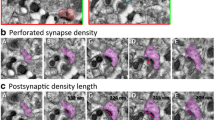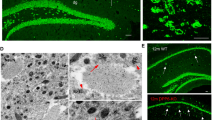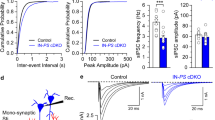Abstract
We examined synaptic function in the hippocampus of aged mice deficient for the Parkinson’s disease-linked protein, parkin. Surprisingly, heterozygous but not homozygous parkin-deficient mice exhibited impairments in basal excitatory synaptic strength. Similarly heterozygous mice exhibited broad deficits in paired-pulse facilitation, while homozygous parkin-deficient mice exhibited more restricted deficits. In contrast to the measurements of basal synaptic function, synaptic plasticity was not altered in aged heterozygous parkin-deficient mice, but was enhanced in aged homozygous parkin-deficient mice, due to an absence of age-related decline. These findings of differential synaptic phenotypes in heterozygous vs. homozygous parkin deficiency suggest compensatory responses to genetic abnormalities could play an important role during the development of pathology in response to parkin deficiency.



Similar content being viewed by others
References
Almaguer-Melian, W., et al. (2000). Synaptic plasticity is impaired in rats with a low glutathione content. Synapse, 38, 369–374.
Bruck, A., et al. (2004). Hippocampal and prefrontal atrophy in patients with early non-demented Parkinson’s disease is related to cognitive impairment. Journal of Neurology, Neurosurgery and Psychiatry, 75, 1467–1469.
Camicioli, R., et al. (2003). Parkinson’s disease is associated with hippocampal atrophy. Movement Disorders, 18, 784–790.
Chung, K. K., et al. (2001). Parkin ubiquitinates the alpha-synuclein-interacting protein, synphilin-1: Implications for Lewy-body formation in Parkinson disease. Nature Medicine, 7, 1144–1150.
Fallon, L., et al. (2002). Parkin and CASK/LIN-2 associate via a PDZ-mediated interaction and are co-localized in lipid rafts and postsynaptic densities in brain. Journal of Biological Chemistry, 277, 486–491.
Goldberg, M. S., et al. (2003). Parkin-deficient mice exhibit nigrostriatal deficits but not loss of dopaminergic neurons. Journal of Biological Chemistry, 278, 43628–43635.
Goldberg, M. S., et al. (2005). Nigrostriatal dopaminergic deficits and hypokinesia caused by inactivation of the familial Parkinsonism-linked gene DJ-1. Neuron, 45, 489–496.
Greenamyre, J. T., & Hastings, T. G. (2004). Biomedicine. Parkinson’s—divergent causes, convergent mechanisms. Science, 304, 1120–1122.
Helton, T. D., et al. (2008). Pruning and loss of excitatory synapses by the parkin ubiquitin ligase. Proceedings of the National Academy of Sciences USA, 105, 19492–19497.
Horowitz, J. M., et al. (1999). Identification and distribution of Parkin in rat brain. Neuroreport, 10, 3393–3397.
Huynh, D. P., et al. (2003). The autosomal recessive juvenile Parkinson disease gene product, parkin, interacts with and ubiquitinates synaptotagmin XI. Human Molecular Genetics, 12, 2587–2597.
Ibarretxe-Bilbao, N., et al. (2008). Hippocampal head atrophy predominance in Parkinson’s disease with hallucinations and with dementia. Journal of Neurology, 255, 1324–1331.
Itier, J. M., et al. (2003). Parkin gene inactivation alters behaviour and dopamine neurotransmission in the mouse. Human Molecular Genetics, 12, 2277–2291.
Joch, M., et al. (2007). Parkin-mediated monoubiquitination of the PDZ protein PICK1 regulates the activity of acid-sensing ion channels. Molecular Biology of the Cell, 18, 3105–3118.
Kitada, T., et al. (1998). Mutations in the parkin gene cause autosomal recessive juvenile parkinsonism. Nature, 392, 605–608.
Kitada, T., et al. (2007). Impaired dopamine release and synaptic plasticity in the striatum of PINK1-deficient mice. Proceedings of the National Academy of Sciences USA, 104, 11441–11446.
Kitada, T., et al. (2009). Impaired dopamine release and synaptic plasticity in the striatum of parkin−/− mice. Journal of Neurochemistry, 110, 613–621.
Kreitzer, A. C., & Malenka, R. C. (2007). Endocannabinoid-mediated rescue of striatal LTD and motor deficits in Parkinson’s disease models. Nature, 445, 643–647.
Lee, M. J., et al. (2009). Genotype-phenotype correlates in Taiwanese patients with early-onset recessive Parkinsonism. Movement Disorders, 24, 104–108.
Lohmann, E., et al. (2009). A multidisciplinary study of patients with early-onset PD with and without parkin mutations. Neurology, 72, 110–116.
Palacino, J. J., et al. (2004). Mitochondrial dysfunction and oxidative damage in parkin-deficient mice. Journal of Biological Chemistry, 279, 18614–18622.
Perez, F. A., & Palmiter, R. D. (2005). Parkin-deficient mice are not a robust model of parkinsonism. Proceedings of the National Academy of Sciences USA, 102, 2174–2179.
Picconi, B., et al. (2005). Pathological synaptic plasticity in the striatum: Implications for Parkinson’s disease. Neurotoxicology, 26, 779–783.
Prescott, I. A., et al. (2009). Levodopa enhances synaptic plasticity in the substantia nigra pars reticulata of Parkinson’s disease patients. Brain, 132, 309–318.
Riekkinen, P., Jr., et al. (1998). Hippocampal atrophy is related to impaired memory, but not frontal functions in non-demented Parkinson’s disease patients. Neuroreport, 9, 1507–1511.
Rodriguez-Navarro, J. A., et al. (2007). Mortality, oxidative stress and tau accumulation during ageing in parkin null mice. Journal of Neurochemistry, 103, 98–114.
Shimura, H., et al. (2001). Ubiquitination of a new form of alpha-synuclein by parkin from human brain: Implications for Parkinson’s disease. Science, 293, 263–269.
Stichel, C. C., et al. (2000). Parkin expression in the adult mouse brain. European Journal of Neuroscience, 12, 4181–4194.
van Nuenen, B. F., et al. (2009). Heterozygous carriers of a Parkin or PINK1 mutation share a common functional endophenotype. Neurology, 72, 1041–1047.
Von Coelln, R., et al. (2004). Loss of locus coeruleus neurons and reduced startle in parkin null mice. Proceedings of the National Academy of Sciences USA, 101, 10744–10749.
Wang, Y., et al. (2008). DJ-1 is essential for long-term depression at hippocampal CA1 synapses. Neuromolecular Medicine, 10, 40–45.
Watson, J. B., et al. (2002). Age-related deficits in long-term potentiation are insensitive to hydrogen peroxide: Coincidence with enhanced autophosphorylation of Ca2+/calmodulin-dependent protein kinase II. Journal of Neuroscience Research, 70, 298–308.
Watson, J. B., et al. (2006). Age-dependent modulation of hippocampal long-term potentiation by antioxidant enzymes. Journal of Neuroscience Research, 84, 1564–1574.
Zhang, Y., et al. (2000). Parkin functions as an E2-dependent ubiquitin-protein ligase and promotes the degradation of the synaptic vesicle-associated protein, CDCrel-1. Proceedings of the National Academy of Sciences USA, 97, 13354–13359.
Zhu, X. R., et al. (2007). Non-motor behavioural impairments in parkin-deficient mice. European Journal of Neuroscience, 26, 1902–1911.
Acknowledgments
The authors would like to thank Richard Palmiter for providing breeding pairs of parkin-deficient mice. This work was supported by Grants from the National Institute of Mental Health (MH065541) and by The G. Harold and Leila Y. Mathers Charitable Foundation.
Author information
Authors and Affiliations
Corresponding author
Rights and permissions
About this article
Cite this article
Hanson, J.E., Orr, A.L. & Madison, D.V. Altered Hippocampal Synaptic Physiology in Aged Parkin-Deficient Mice. Neuromol Med 12, 270–276 (2010). https://doi.org/10.1007/s12017-010-8113-y
Received:
Accepted:
Published:
Issue Date:
DOI: https://doi.org/10.1007/s12017-010-8113-y




